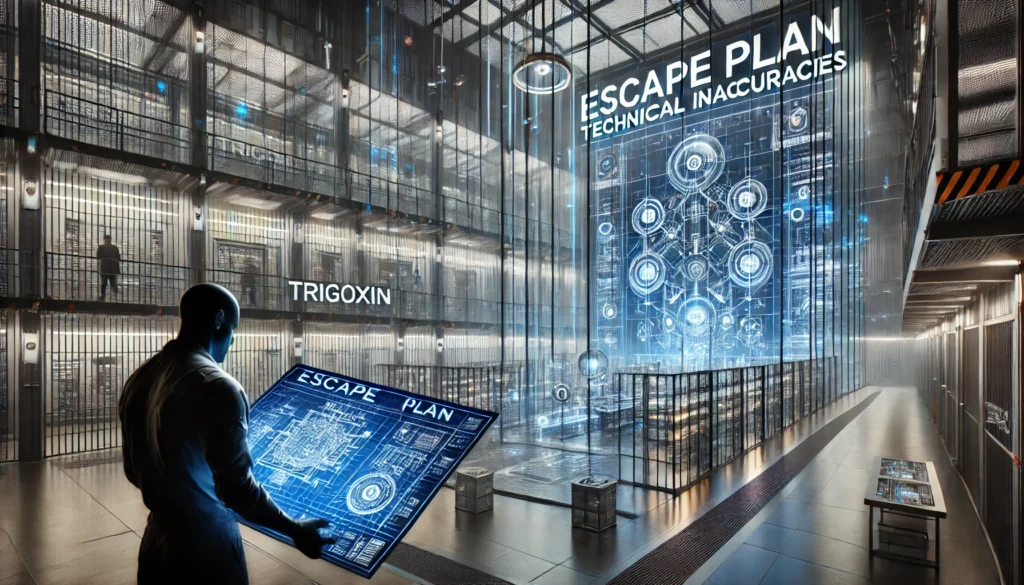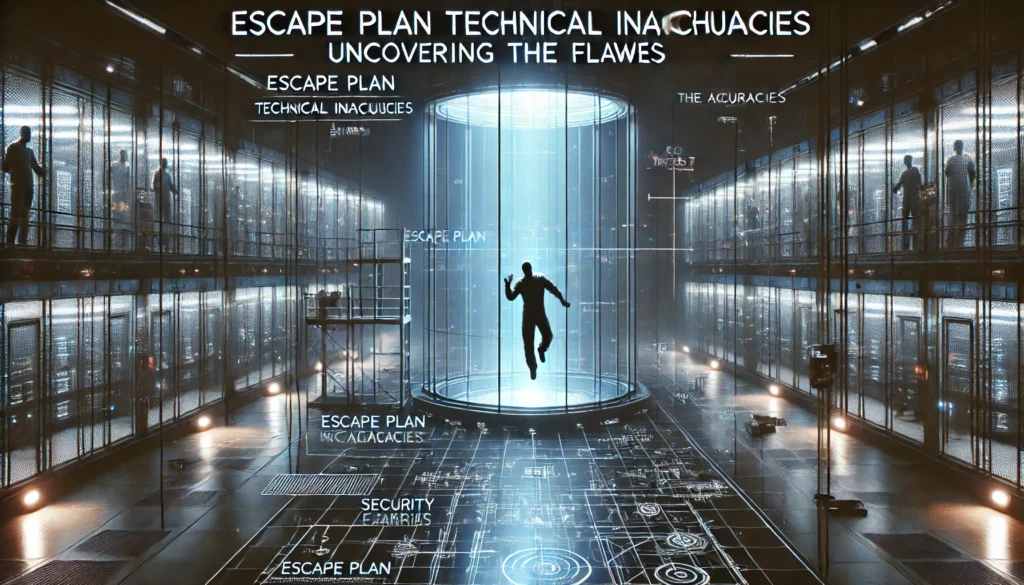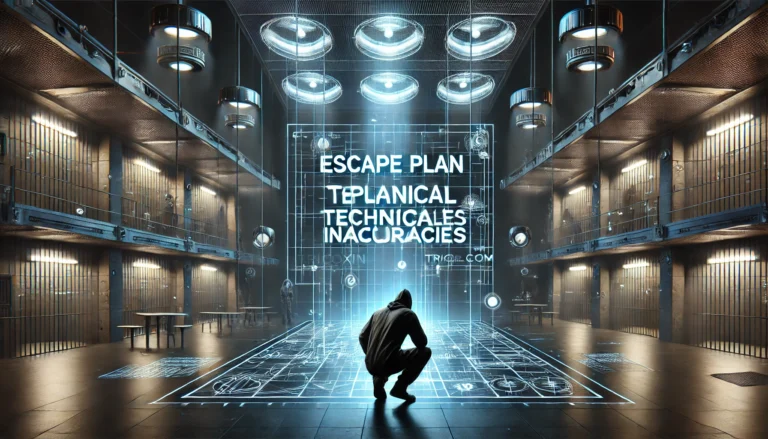Escape Plan Technical Inaccuracies: An In-Depth Look
The 2013 action-thriller movie Escape Plan brought together two action icons, Sylvester Stallone and Arnold Schwarzenegger, in an exhilarating tale of prison escape. While the film’s premise and execution were entertaining, it is not without its flaws, particularly when it comes to technical details. In this article, we’ll dive into the Escape Plan Technical Inaccuracies that left both fans and experts scratching their heads.

Understanding the Premise
Escape Plan centers around Ray Breslin (Stallone), a structural-security expert who tests maximum-security prisons by attempting to break out of them. Hired to evaluate a state-of-the-art facility called “The Tomb,” Breslin encounters challenges that push him to his limits. Despite its gripping storyline, the movie’s depiction of security systems, engineering concepts, and operational procedures often departs from reality, leading to several escape plan technical inaccuracies.
Key Technical Inaccuracies
1. Prison Design and Construction
The high-tech prison depicted in Escape Plan is portrayed as a virtually impenetrable fortress, with glass cells suspended in mid-air and cutting-edge surveillance systems. While visually impressive, the design is rife with escape plan technical inaccuracies. For instance:
- Structural Impracticalities: The glass cells, though intimidating, would be highly impractical in a real prison setting. Glass is not only more expensive than steel but also easier to compromise.
- Ventilation Systems: The film’s depiction of large, accessible air ducts is a common Hollywood trope. In reality, such ducts are designed to be too small for human passage.
- Material Limitations: The materials used in such a futuristic prison would require advanced manufacturing techniques and maintenance far beyond what is practical or feasible in real-world applications.
2. Surveillance Oversights
Despite boasting advanced surveillance, the prison’s security team overlooks several critical aspects. For example:
- Blind Spots: The facility has numerous blind spots that allow inmates to conspire without being detected. Modern prisons use 360-degree cameras to eliminate such vulnerabilities.
- Human Error: The guards frequently ignore suspicious behavior, a recurring theme in the movie’s escape plan technical inaccuracies.
- Facial Recognition: In a prison supposedly equipped with cutting-edge technology, the lack of robust facial recognition systems seems like a glaring oversight.

3. Technical Tools and Hacks
Breslin’s ability to create improvised tools from everyday objects is impressive but far-fetched. Some notable escape plan technical inaccuracies include:
- Fabrication of Tools: Constructing a sextant from scraps might be theoretically possible but is highly implausible under the strict conditions of a maximum-security prison.
- Electronic Manipulation: Hacking into high-tech systems with rudimentary tools is another glaring inaccuracy. Such systems are designed to be tamper-proof and require specialized knowledge and equipment to breach.
- Time Constraints: The time Breslin spends assembling and executing these tools often feels unrealistic given the constant surveillance and pressure.
4. Behavioral Oversights
The psychological manipulation Breslin employs to outwit the guards and inmates often stretches credibility. Real-world prison staff are trained to recognize and counter such tactics, highlighting another aspect of escape plan technical inaccuracies. Moreover:
- Inmate Collaboration: Convincing hardened criminals to collaborate seamlessly in a high-stakes situation is much more difficult than portrayed.
- Guard Reactions: The guards’ repeated failure to adapt to Breslin’s tactics reflects a lack of realism in security training and protocols.
5. Escape Logistics
The climactic escape sequence is thrilling but filled with implausible moments. Examples include:
- Timing Precision: The level of timing required to coordinate the escape stretches the limits of believability.
- Resource Availability: Access to the necessary tools and information often seems too convenient, undermining the tension of the story.

Why Do These Inaccuracies Matter?
While some may argue that the movie’s purpose is entertainment, not realism, the escape plan technical inaccuracies detract from the immersive experience for viewers familiar with security protocols. Realism in movies enhances credibility and helps audiences connect with the story on a deeper level.
Furthermore, inaccuracies can sometimes overshadow the movie’s strengths. By drawing attention away from the characters and plot, these flaws may leave viewers focusing more on what doesn’t make sense rather than what does.
Real-World Comparisons
To understand the escape plan technical inaccuracies, it’s worth comparing the film to actual prison systems:
- Maximum-Security Facilities: Real prisons like ADX Florence in Colorado prioritize isolation, robust surveillance, and minimal human interaction to prevent escapes.
- Escape Attempts: Historically, successful escapes from maximum-security prisons involve months or years of meticulous planning, not the rapid, improvised solutions seen in the movie.
- Technology in Prisons: Modern facilities utilize AI-driven surveillance, biometric scanning, and tamper-proof materials—elements conspicuously absent or underutilized in Escape Plan.
Lessons for Filmmakers
To avoid escape plan technical inaccuracies, filmmakers should:
- Consult Experts: Collaborating with structural engineers, security consultants, and prison staff can lend authenticity to the story.
- Balance Realism with Creativity: Striking the right balance ensures that the plot remains engaging without alienating knowledgeable viewers.
- Avoid Overused Tropes: Steering clear of clichés, like oversized air ducts or inept guards, can make the story more believable.
- Test Realism: Running scenarios by experts or conducting mock exercises can highlight potential flaws in the script.
Conclusion
Despite its flaws, Escape Plan remains a thrilling ride for fans of the action genre. However, its numerous escape plan technical inaccuracies highlight the importance of thorough research and realistic storytelling. By addressing these issues, filmmakers can craft stories that are not only entertaining but also grounded in reality. If you’re intrigued by the intersection of fiction and technical accuracy, analyzing escape plan technical inaccuracies can offer valuable insights into the art of filmmaking.
The movie serves as a reminder that even the most exciting stories benefit from a touch of authenticity. Whether you’re a fan dissecting the details or a filmmaker seeking to improve your craft, exploring escape plan technical inaccuracies provides an engaging way to merge entertainment with education.
FAQ: Escape Plan Technical Inaccuracies
1. What is the main premise of Escape Plan?
Escape Plan is a 2013 action-thriller movie featuring Sylvester Stallone and Arnold Schwarzenegger. The plot follows Ray Breslin, a structural-security expert, as he tests and escapes from maximum-security prisons. The film is filled with thrilling action but also includes several technical inaccuracies regarding prison design, security systems, and escape strategies.
2. What are “escape plan technical inaccuracies”?
“Escape plan technical inaccuracies” refer to the unrealistic or incorrect portrayals of prison systems, escape methods, and security technologies shown in the movie. These inaccuracies often involve exaggerated depictions of prison designs, flawed surveillance systems, and implausible escape tactics.
3. Why are the prison designs in Escape Plan considered inaccurate?
The prison in the film, known as “The Tomb,” is depicted as a futuristic fortress with glass cells suspended in mid-air and large, accessible air ducts. These designs are visually striking but highly impractical for real-world prisons due to structural, cost, and security constraints.
4. Are the surveillance systems in the movie realistic?
No, the surveillance systems in Escape Plan are riddled with flaws. The prison is shown to have numerous blind spots and relies heavily on human guards who frequently overlook suspicious activities. In contrast, real maximum-security prisons use advanced 360-degree cameras, biometric systems, and AI-driven monitoring to prevent such oversights.
5. Can improvised tools like the ones shown in the movie work in real life?
While theoretically possible, the improvised tools shown in Escape Plan are highly implausible in real-world conditions. For example, creating a sextant from scrap materials or hacking advanced systems with basic tools would be nearly impossible in a secure prison environment.
6. How realistic is the psychological manipulation used in the movie?
The psychological tactics employed by Ray Breslin are often exaggerated. In real prisons, staff are trained to recognize and counter manipulation attempts. Convincing both guards and inmates to act against their interests would require significantly more time and effort than what is portrayed in the film.
7. How do real maximum-security prisons compare to the one in Escape Plan?
Real maximum-security prisons, such as ADX Florence in Colorado, prioritize isolation and strict surveillance. They are designed to minimize human interaction, eliminate blind spots, and use tamper-proof materials. Unlike the prison in the movie, these facilities are not prone to the kind of vulnerabilities exploited by Ray Breslin.
8. What are some common Hollywood tropes about prisons seen in the movie?
Escape Plan relies on several common Hollywood tropes, including:
- Oversized air ducts that allow human passage.
- Guards who are easily distracted or incompetent.
- High-tech systems that are easily hacked with makeshift tools.
- Elaborate escape plans that come together with improbable precision.
9. Why do these inaccuracies matter?
For viewers familiar with prison security or engineering, the escape plan technical inaccuracies can detract from the film\u2019s believability. While entertainment often takes precedence over realism, excessive inaccuracies can pull audiences out of the story and undermine its credibility.
10. How can filmmakers avoid such inaccuracies in the future?
To minimize technical inaccuracies, filmmakers should:
- Consult experts, such as structural engineers and prison security consultants.
- Avoid overused tropes and strive for originality.
- Balance creative liberties with elements of realism.
- Conduct mock scenarios or expert reviews to test the plausibility of their storylines.
11. Is Escape Plan worth watching despite its inaccuracies?
Absolutely! Escape Plan is an entertaining action movie that brings together two iconic stars. While the escape plan technical inaccuracies are noticeable, they don\u2019t entirely overshadow the film\u2019s gripping plot and action-packed sequences.
12. What are some real-life examples of successful prison escapes?
Historical escapes, such as the 1962 Alcatraz escape and the 2015 Clinton Correctional Facility breakout, involved meticulous planning, extensive knowledge of prison systems, and years of preparation. These real-life events highlight the stark contrast between Hollywood fiction and the challenges of actual prison escapes.
13. What lessons can viewers learn from analyzing escape plan technical inaccuracies?
By examining the inaccuracies in Escape Plan, viewers can develop a deeper appreciation for the complexities of real-world security systems. It also underscores the importance of research and attention to detail in storytelling, especially when tackling technical subjects.
14. Can inaccuracies like these harm a movie’s reputation?
In some cases, yes. While casual viewers might overlook them, technical inaccuracies can alienate knowledgeable audiences and lead to critical scrutiny. For example, experts in security or engineering might find the errors distracting, impacting their overall enjoyment of the film.
15. Are there other movies with similar issues?
Many action and thriller movies, such as The Shawshank Redemption, Prison Break (the series), and The Rock, feature similar technical inaccuracies. These films often prioritize dramatic tension over realism, leading to exaggerated depictions of prison escapes and security flaws.
16. Does the entertainment value outweigh the inaccuracies?
For most viewers, the entertainment value of Escape Plan outweighs its technical inaccuracies. The chemistry between Stallone and Schwarzenegger, combined with high-stakes action, makes the movie a thrilling experience despite its flaws.
17. How does Escape Plan balance fiction and reality?
While Escape Plan incorporates elements of realistic prison systems, it heavily leans into fictional scenarios to create dramatic tension and excitement. This balance often tips toward fiction, leading to noticeable escape plan technical inaccuracies.
18. Could such a prison exist in the real world?
The futuristic prison depicted in Escape Plan is highly unlikely to exist in reality. The costs, maintenance, and security challenges associated with such a facility would make it impractical for any government or private entity to implement.
19. What can fans expect from sequels to Escape Plan?
The sequels, Escape Plan 2: Hades and Escape Plan 3: The Extractors, continue the franchise\u2019s focus on daring escapes but face similar criticisms regarding technical inaccuracies. Fans of the genre can expect more action-packed sequences but should prepare for a suspension of disbelief.
20. Why is discussing escape plan technical inaccuracies important?
Analyzing these inaccuracies allows viewers to better understand the divide between Hollywood storytelling and real-world feasibility. It encourages critical thinking and fosters a deeper appreciation for the effort required to create compelling, believable narratives in cinema.

